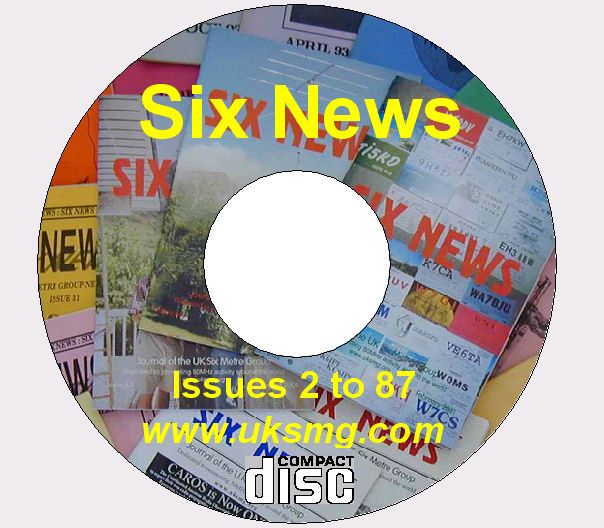|
Background
information
Mellish Reef is an external territory of Australia, situated about
1000km east of Cairns off mainland Australia, virtually half way
across to Vanuatu and centrally located in the Coral Sea. The reef
itself is approximately 10km long by 3km wide but it is totally
submerged when the sea is above half tide. The only land mass is
“Herald Beacon Islet”, a 600m long by 120m wide sand cay which stands
two metres above the high water line. Native inhabitants include
a few varieties of birds (in the thousands!), hermit crabs, ladybirds
and the occasional spider.
A survey trip out to Mellish was made in April 2001 to see if the
reef was still there and to evaluate its accessibility. During their
brief four-day visit the survey team operated on a limited number
of bands, including six metres. Over 10,400 QSOs were made (1,473
on six metres) and from the response received it was decided that
we would definitely have to return and activate Mellish on a larger
scale.
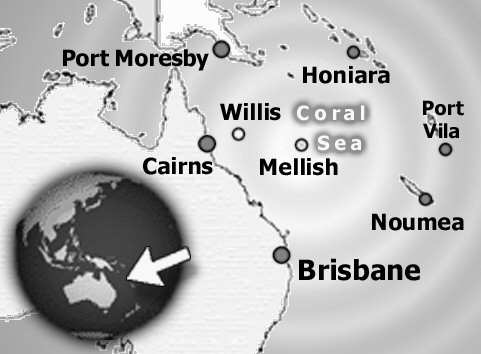
Mellish
Reef lies in the Coral Sea, 1000km east
of mainland Australia
The
2002 trip
The 2002 team comprised 11 members, 10 of whom were amateurs from
Australia, New Zealand, Japan, the USA. and the UK. Transportation
to the reef was by two privately owned racing catamarans around
43’ in length. “Bach & Byte” was skippered by team leader David
Gemmell VK4GL, while although Geoff Toomey, the skipper of “Spellbound”,
wasn’t an amateur he thought it might be a great trip for the sailing,
fishing and diving alone. Apart from a serious effort on low-bands
and WARC there was also a dedicated station for six metres, the
running of which was shared by three keen street-wise six metre
operators.
In reply to a question on what he was looking forward to on the
VK9ML Mellish Reef Dxpedition, Katsu Ono, JH7OHF, said: "I
want to work big JA pile up on six metres!". Little did Katsu
realise that his wish would be granted… in spades! Ten days later,
with more than four thousand contacts in the log, Katsu was more
than happy with the overall result of the six metre effort. Together
with Alan Meek, VK4WR and Peter Garden, VK4APG, Katsu had provided
the best chance yet for thousands of six metre fanatics in the Pacific-rim
area and beyond to work a new one and also to work Mellish on six
metres by modes rarely offered before – RTTY and AM.
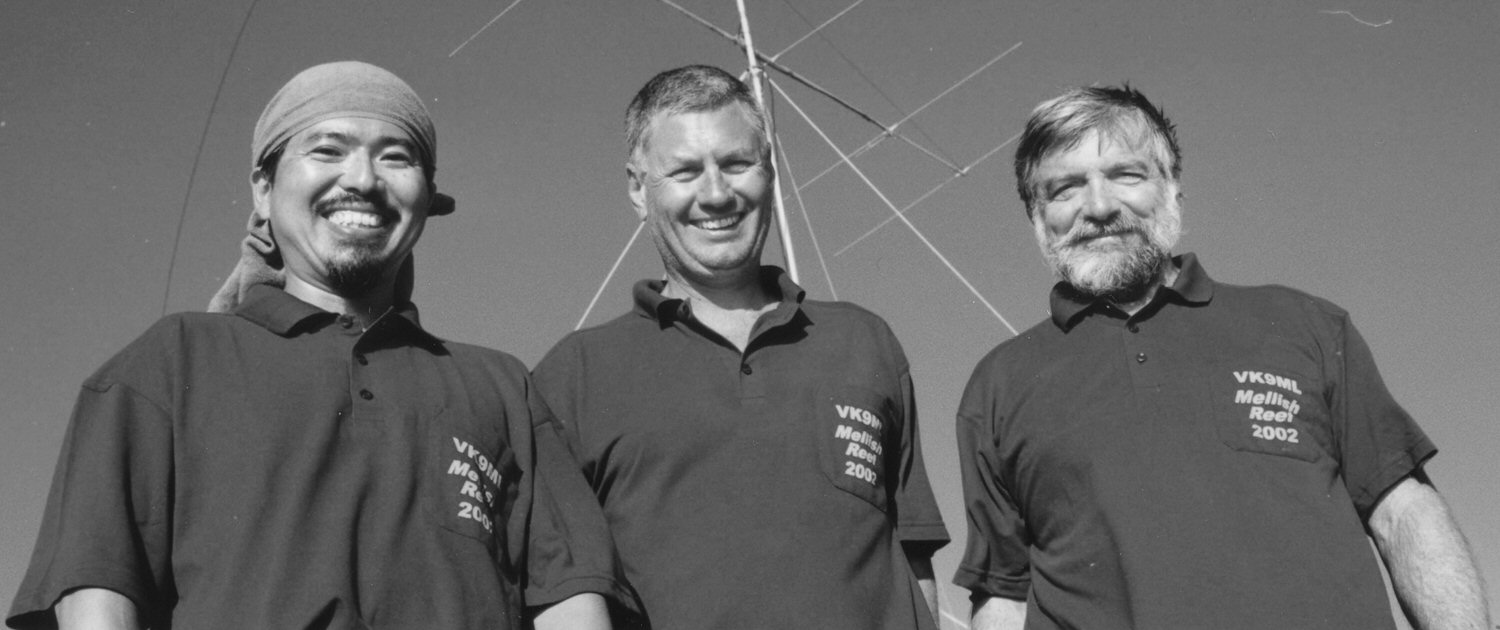
The VK9ML 2002 six metre crew L-R: Katsu JH7OHF,
Alan VK4WR and Peter VK4APQ
Land
ho!
It was an arduous and longer than expected, six-day sail out to
Mellish. Once landed, the 30’ mast for the six metre yagi was to
be utilized as the gin pole for the erection of the BattleCreek
Special 160/80/40m vertical, but the weary and tired crew gave up
on erecting the BCS for the first night. When nobody else was looking,
Peter & Katsu stole the former “gin pole", and in the moonlight,
the six-metre yagi was attached to the pole and raised to point
NNW - long path to South America.
The timing of the DXpedition was affected by two major influences:
avoiding the cyclone season and wanting to take advantage of the
best possible propagation conditions for the higher bands such as
10m and six metres. Cyclone season in the Australian tropics runs
from October – March, so April was really the earliest we could
sail out with some degree of confidence that we wouldn’t be troubled
with cyclonic activity. The propagation? “BINGO!" on the first
night (15/4/02) long-path into South America with Peter PY5CC (who
else?) at 11:57 and Fred PY2XB later at 12:42. The six metre team
were beside themselves with joy! Gin pole? No, haven’t seen it!
Just ask any VK operator how tough the path to South America is
and you’ll learn the only path is via the long path, and that might
only occur half a dozen times per cycle.
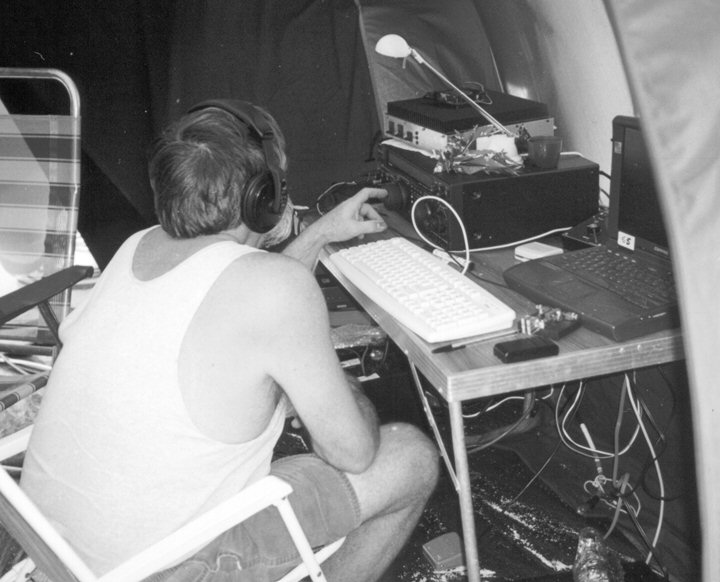
The six metre operating position
with VK4APG on duty.
April also meant
conditions should be very good for TEP contacts into Asia, and we
weren’t disappointed. The logging computer was kept busy with at
least twice-daily openings to JA, HL VR2, BY and BV. Late afternoons
had potential for Middle East openings and news one day from our
Co-ordinating Pilot and Webmaster Adam, VK4CP, that A45XR had heard
the beacon on 19/4/02 07:14 at 519. The following day was the payoff
in that direction with VU2LO worked on 20/04/02 07:25 (and also
on the last night of six metres operation 24/04/02 05:43, just a
few hours before six metres rig pack-up time). Speaking of rigs,
the Yaesu FT-920 performed flawlessly, often running in beacon mode
at the 100-watt level on our prime TX frequency of 50.145MHz.
This year we employed the strategy of operating both CW and SSB
on the same frequency, which meant our customers knew where to listen
for us irrespective of which mode we were operating at the time,
or whether the six metres rig was running in beacon mode. We believe
this strategy should be used by all DXpeditions that attempt a serious
six-metre effort.
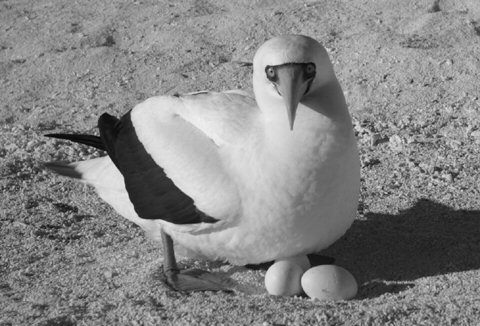
One of the native Booby birds.
240VAC power
for the six metre station was provided by a Honda EU-10i Inverter
generator. The Honda EU series of generators are reliable, high-tech,
low weight, efficient sources of clean 240V and 12VDC suitable for
charging 12V batteries – handy, as Katsu's TE Systems 350 watt amplifier
was powered by a deep cycle lead/acid battery (VK9 territories have
a 400W power limit).
The yagi was the highly regarded five-element K6STI optimised design
(see “Six News” Oct `93 issue 39, or checkout the UKSMG on-line
archive for more information). This very same yagi was used last
year on Mellish, at VK9WI Willis Island (May 2000) and by H44PT
(April 2000).
April 19th and 20th provided two days in a row with unusually strong
backscatter from the north west, which allowed contacts with ZL
and every state of VK. On one of these mornings many VK4s were also
treated to a very rare opening into Indonesia, providing a new country
for many. Funny, so close and yet so hard to work! During one amazingly
strong opening into South East Asia, four Indonesian stations were
worked off the front of the beam while Costa Rican stations were
calling off the back of the beam. This was during one of the rare
excursions to 50.110. The misperception that only 10-15kHz works
in the 50MHz band is still alive and well in some areas. To increase
the country count, a quick QSY to look down the band for those not
prepared to move up had to be made. Stations dredged up on 50.110
were encouraged to QSY up and make the QSO on 50.145 - this also
helped prevent being spotted on 110, something that would have been
counter-productive.
The almost daily morning opening to Central America short path had
all operators very confident of openings further a field. However,
the North American path just wouldn't open except for XE and K6XQ,
Jack in San Diego. Frustrating also was the lack of Caribbean propagation
other than to David ZF1DC, but this was also being experienced back
on mainland VK…. especially by one very keen six metres enthusiast
Pilot!
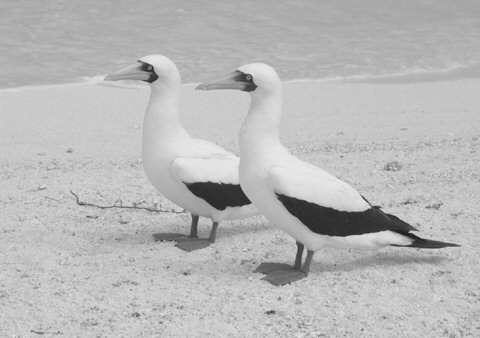
A pair of Boobies.
Peter was generally
out of his bunk at dawn each morning to drive the dinghy ashore
to turn the beam to North America. Whenever the station was manned,
the amp was used to try and eke out something from the North East.
On the second to last morning of operation, April 23rd, Alan was
running a big 10m SSB pile up of North and South Americans when
Dianna, KB6NAN broke in to say that the six metre beacon was pouring
into California but no one was there to respond to the calls. Instantly
Alan ceased operations on 10m and rushed over to the six metre tent.
Yes the beacon was running and yes there were stations calling!
Katsu was still asleep after operating all night on 24MHz and as
Peter was onboard the catamaran it looked like Alan’s lucky day
for some exciting six metre operating. All hell broke loose with
59 signals, and between 22:40 – 23:32 twenty eight W6 stations were
worked. Heartening news was that they were not just the big guns
you normally hear and work, and, for one lucky punter his contact
with VK9ML was his first ever DX on Six! Well done Dianna, and thanks
for that heads-up!
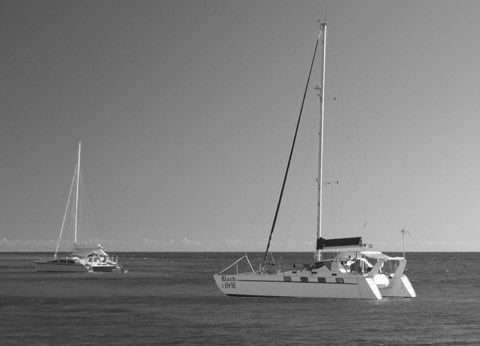
The catamarans moored in the lagoon.
Successful?
You bet!
Although the chances of working into Europe at this time of the
year were slim, the VK9ML 2002 DXpedition was otherwise highly successful.
So far it has been the biggest operation from Mellish Reef and was
the first DXpedition to use 2.4GHz wireless LAN technology with
its computer systems, which by the way operated flawlessly. (I’m
sure Murphy took some time off after dishing out such terrible sailing
conditions on the way out to the reef!)
Wireless networking meant no messy cables to trip over! Being server
based we were able to download log data off the server box without
disrupting the operation of any of the logging computers at the
five Yaesu stations. The logging and server software was courtesy
of the 5-Star DXers Association (the same as used at D68C), and
we thank John Linford G3WGV for his great help. Not only were the
VK9ML on-line logs the quickest in amateur radio history, but, this
DXpedition set a new record with the number of six metre QSOs made:
4,298 to be precise, largely JA, but 23 countries, 13 zones and
4 continents were worked as follows:
QSOs per mode:
CW: 1,469
SSB: 2,627
AM: 56
RTTY: 146
Twenty-three
countries and one wet square were worked, in the following order:
DXCC QSOs 1st
QSO DATE UTC
JA 4061 JA8ISU 15/04/02 10:08
KH6 13 KH6SX 15/04/02 10:13
HL 54 HL1LTC 15/04/02 11:24
VR2 19 VR2KW 15/04/02 11:35
BY 7 BD7NI 15/04/02 11:48
PY 2 PY5CC 15/04/02 11:57
BV 2 BV2FI 15/04/02 12:49
K,W,N 35 N6XQ 17/04/02 00:10
VK 61 VK2ZXC 18/04/02 22:01
ZL 3 ZL3TY 18/04/02 22:05
TI 12 TI5KD 18/04/02 22:10
XE 3 XE2HWB 18/04/02 22:13
TG 1 TG9NX 18/04/02 22:38
HP 5 HP2CWB 18/04/02 23:13
YB 5 YB5QZ 19/04/02 00:06
FK 2 FK8HA 19/04/02 00:43
YJ 3 YJ8UU 19/04/02 01:01
ZF 1 ZF1DC 19/04/02 21:17
KH8 1 AH8A 19/04/02 21:19
9M2 1 9M2/JI1ETU 20/04/02 00:30
FO 1 FO3BM 20/04/02 01:41
VU 3 VU2LO 20/04/02 07:25
V73 1 V73AT 22/04/02 10:29
1 Z32ZM/MM 23/04/02 08:09
It was a four-day
wait to work back into mainland VK and the closest station worked
was Gary, VK4ABW, in Townsville at 960km. The furthest station worked
by the short-path was David ZF1DC, at a distance of 13,992km. Best
long-path was PY5CC at 25,548km with PY2AB not far behind at 25,247km.
From the country table above you’ll note that Mome, Z32ZM, was worked
signing /MM whilst travelling out to Baker Island.
By the following week VK9ML was just a wonderful memory and whilst
the K1B team were beginning to enjoy their turn under the spotlight
our intrepid team were making their way back home. Some of our international
team members would have been away from family and home for almost
a month… all in the name of activating a hunk of sand in the middle
of nowhere! Should we also mention it was great fun?
Website
More than 100 pictures of the DXpedition can be seen in the “Gallery”
at the VK9ML website: http://www.qsl.net/vk9ml/2002/

The VK9ML QSL card
UKSMG Six News issue
74, August 2002 |
|


